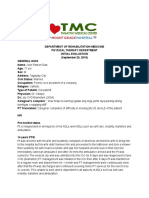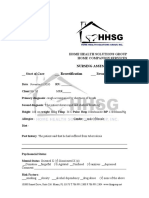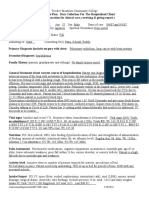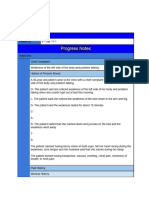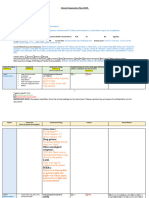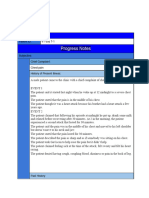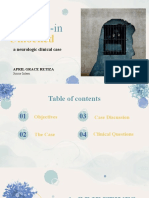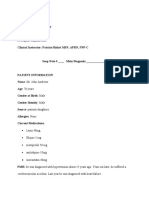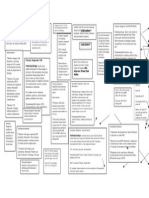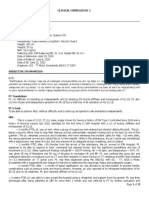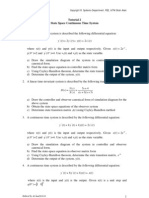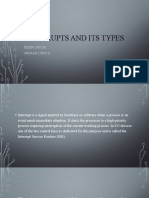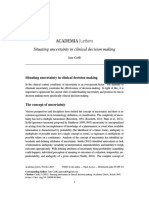Case 8 Subjective: Here to follow up on her atrial fibrillation. |1| No new problems. Feeling well.
Medications are per medication sheet. These were reconstituted with the medications that she was
discharged home on. Objective: Blood pressure is 110/64. Pulse is regular at 72. Neck is supple. Chest is
clear. Cardiac normal sinus rhythm. Assessment: Atrial fibrillation, currently stable. |2| Plan: 1.
Prothrombin time to monitor long term use of anticoagulant. |3| 2. Follow up with myself in 1 month,
sooner as needed if has any other problems in the meantime. Will also check a creatinine and potassium
today as well. _____________________________________________________________ |1| Patient
returns for a follow up visit for atrial fibrillation. |2| Report a code for the definitive diagnosis. |3|
Status code reported for long term use of anticoagulants.
_____________________________________________________________ What diagnosis/es code(s)
are reported? ICD-10-CM Code: I48.91, Z79.01 Rationale: From the Index to Diseases and Injuries, look
for Fibrillation/atrial or auricular. You are referred to I48.91. For the next diagnosis, look for Long-term
(current) (prophylactic) drug therapy (use of)/anticoagulants. You are referred to Z79.01. Verify both
codes in the Tabular List. Case 9 Follow-Up Visit: The patient has some memory problems. |1| She is
hard of hearing. She is legally blind. Her pharmacist and her family are very worried about her memory
issues. She lives at home, family takes care of laying out her medications and helping with the chores
but she does take care of her own home to best of her ability. Exam: Pleasant elderly woman in no acute
distress. She has postop changes of her eyes. TMs are dull. Pharynx is clear. Neck is supple without
adenopathy. Lungs are clear. Good air movement. Heart is regular. She had a slight murmur. Abdomen is
soft. Moderately obese. Nontender. Extremities no clubbing or edema. Foot exam shows some bunion
deformity but otherwise healthy as consequence. Light touch is preserved. There is no ankle edema or
stasis change. Examination of the upper arms reveal good range of motion. There is significant pain in
her shoulder with rotational movements. It localized mostly over the deltoid. There is no other
deformity. There is a very slight left shoulder discomfort and slight right hip discomfort. Impression: 1.
Type 2 diabetes good control. |2| Most recent AlC done today 5.9%. Liver test normal. Cholesterol 199,
LDL a little high at 115. 2. Right shoulder pain. |3| 3. Benign hypertensive cardiovascular disease. |3| 4.
Dementia |3| Plans: 1. I offered her and her family neuropsych eval to evaluate for dementia. |4| Her
system complex is consistent with dementia whether it be from small vascular disease or Alzheimer’s is
unknown. At this point they much rather initiate treatment than go through an exhaustive neuropysch
test. 2. For the shoulder we decided on right deltoid bursa aspiration injection. |5| She has had injection
for bursitis in the past
D-10-CM Coding Chapters 1–11 Chapter 4 Procedure: Aspiration injection right deltoid bursa. The point
of maximal tenderness was identified, skin was prepped with alcohol. A 25-gauge 1 ½-inch needle was
advanced to the humerus and then aspired. 1 cc of 0.25% Marcaine mixed with 80 mg Depomedrol was
deposited. Needle withdrawn. Band-Aid applied. Post injection she had marked improvement, increased
range of motion consistent with good placement of the medication. She was started on cerefolin plus
NAC and Aricept starter pack was given with email away script. Follow up in 3 months and we will
reassess her dementia at that time.
_____________________________________________________________ |1| A presenting problem. |
�2| Provider documents the type of diabetes and that it is controlled. |3| Report codes for all definite
diagnoses that were treated. |4| Recommendation for evaluation to determine the cause of dementia. |
5| Treatment documented for right shoulder pain.
_____________________________________________________________ What diagnosis/es code(s)
are reported? ICD-10-CM Codes: E11.9, M25.511, I11.9, F03.90 Rationale: The patient has multiple
diagnoses. It is important to report the diagnoses that the provider treated during the encounter and
any chronic conditions that affect the care of the patient. The provider documents the patient has
controlled Type II diabetes. From the Index to Diseases and Injuries, look for Diabetes, diabetic/type 2
referring you to code E11.9. The provider performs a joint injection to treat the patient’s right shoulder
pain. From the Index to Diseases, look for Pain(s)/joint/shoulder. You are referred to M25.51-. Turn to
the Tabular List for the sixth character to indicate the right shoulder; M25.511. The patient is also
diagnosed with benign hypertensive cardiovascular disease. The provider reviewed the labs (cholesterol
and LDL) to monitor this condition. From the Index to Diseases and Injuries, look for Hypertension,
hypertensive (benign)/cardiovascular/ disease (arteriosclerotic) (sclerotic) – see Hypertension, heart.
Look for Hypertension, hypertensive (benign)/heart. You are referred to I11.9. The last diagnosis listed is
dementia. The provider is not sure of the cause. Look for Dementia. You are referred to F03.90. Verify
codes in the Tabular List for accuracy. Case 10 CC: HTN Interval History: No new complaints. Exam: NAD.
130/80, 84, 22. Lungs are clear. Heart RRR, no MRGs. Abdomen is soft, non-tender. No peripheral
edema. Impression: Stable HTN |1| on current meds. Plan: No changes needed. RTC in six months with
labs. _____________________________________________________________ |1| Patient is diagnosed
with hypertension. _____________________________________________________________ What
diagnosis/es code(s) are reported? ICD-10-CM Codes: I10 Rationale: From the Index to Diseases and
Injuries lo






